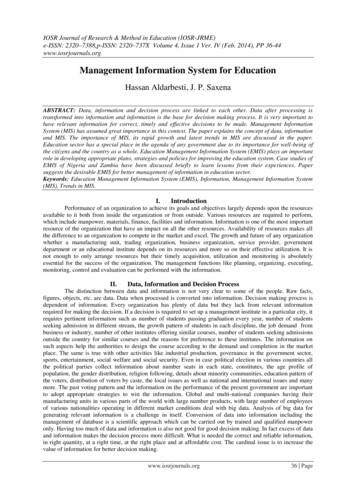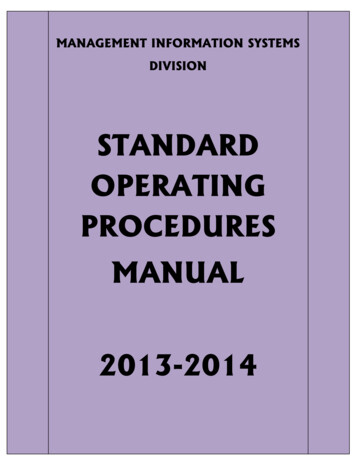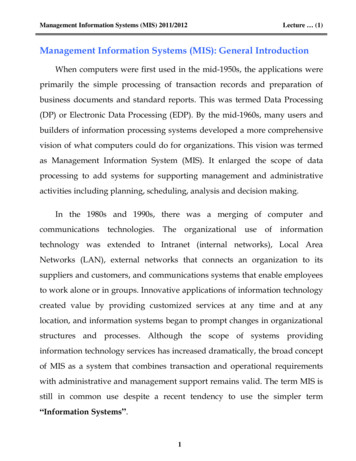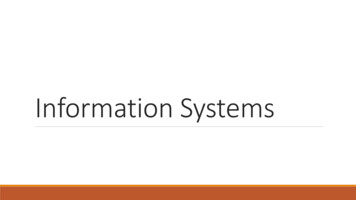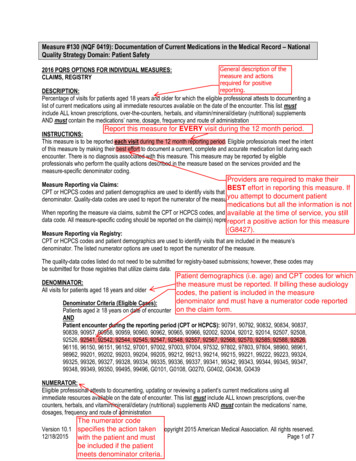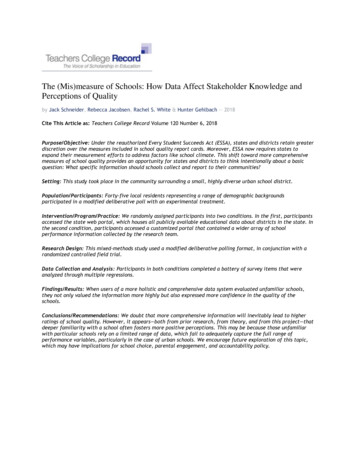
Transcription
The (Mis)measure of Schools: How Data Affect Stakeholder Knowledge andPerceptions of Qualityby Jack Schneider, Rebecca Jacobsen, Rachel S. White & Hunter Gehlbach — 2018Cite This Article as: Teachers College Record Volume 120 Number 6, 2018Purpose/Objective: Under the reauthorized Every Student Succeeds Act (ESSA), states and districts retain greaterdiscretion over the measures included in school quality report cards. Moreover, ESSA now requires states toexpand their measurement efforts to address factors like school climate. This shift toward more comprehensivemeasures of school quality provides an opportunity for states and districts to think intentionally about a basicquestion: What specific information should schools collect and report to their communities?Setting: This study took place in the community surrounding a small, highly diverse urban school district.Population/Participants: Forty-five local residents representing a range of demographic backgroundsparticipated in a modified deliberative poll with an experimental treatment.Intervention/Program/Practice: We randomly assigned participants into two conditions. In the first, participantsaccessed the state web portal, which houses all publicly available educational data about districts in the state. Inthe second condition, participants accessed a customized portal that contained a wider array of schoolperformance information collected by the research team.Research Design: This mixed-methods study used a modified deliberative polling format, in conjunction with arandomized controlled field trial.Data Collection and Analysis: Participants in both conditions completed a battery of survey items that wereanalyzed through multiple regressions.Findings/Results: When users of a more holistic and comprehensive data system evaluated unfamiliar schools,they not only valued the information more highly but also expressed more confidence in the quality of theschools.Conclusions/Recommendations: We doubt that more comprehensive information will inevitably lead to higherratings of school quality. However, it appears—both from prior research, from theory, and from this project—thatdeeper familiarity with a school often fosters more positive perceptions. This may be because those unfamiliarwith particular schools rely on a limited range of data, which fail to adequately capture the full range ofperformance variables, particularly in the case of urban schools. We encourage future exploration of this topic,which may have implications for school choice, parental engagement, and accountability policy.
The (Mis)measure of Schools: How Data Affect Stakeholder Knowledge andPerceptions of Qualityby Jack Schneider, Rebecca Jacobsen, Rachel S. White & Hunter GehlbachOver the past two decades, the amount of publicly available educational data has exploded. Due primarily to NoChild Left Behind (NCLB) and its successor, the Every Student Succeeds Act (ESSA), anyone with an Internetconnection can access a state-run data system housing reams of information about districts and schools.One of the chief aims in developing these systems has been to inform the public. With more information aboutschool quality, it is presumed, parents will become more active in making choices, and communities will exertstronger pressure for accountability. In keeping with this belief, policy makers have expanded public access toschool performance data (e.g., Duncan, 2010). And though use of these systems differs across demographic groups,it does appear that educational data do shape stakeholder behavior (Hastings & Weinstein, 2008).If these information systems are designed to instruct behavior, it seems appropriate to ask how well they inform.Certainly users can learn a great deal from examining the data collected and made available by the state. Butwhat kind of picture do they get of a school? Given the strong orientation of these systems toward standardizedtest results, it may be that data answer only some questions about school performance. And if that is the case—ifthe information is partial—these systems may produce biased perceptions of school quality.Some evidence suggests that state data systems, despite their potential value, have produced a troubling sideeffect: undermining public confidence in public education. Americans have long expressed more positive viewstoward the schools they know well—the schools attended by their own children—as compared with schools ingeneral. But ratings of unfamiliar schools dipped to a new nadir during the NCLB era (Rhodes, 2015). In 2002, theyear NCLB was signed into law, 60% of respondents in the annual Phi Delta Kappan/Gallup poll gave the nation’spublic schools a ―C‖ or a ―D‖ grade (Rose & Gallup, 2002). Thirteen years later, 69% gave the schools a ―C‖ or ―D‖(Bushaw& Calderon, 2015). Of course, these more negative responses may reflect a clearer sense of reality, or realdeclines in quality. Yet parents have continued to rate their own children’s schools quite positively: The 72% ofrespondents who gave their children’s schools an ―A‖ or a ―B‖ in 2015, for instance, mirrors the 71% who did so in2002. Such discrepancies present a puzzle. Why do parents view unfamiliar schools so much more pessimisticallythan they view their own, familiar schools? What information is shaping their views?If current data systems inform only partially, and if they foster unreasonably negative perceptions, we mightquestion the sufficiency of what those systems include. Current changes in ESSA require state education agenciesto incorporate at least one other indicator of school quality or student success—above and beyond students’ testscores—in their public reporting. They suggest a variety of measures that could meet this requirement, includingstudent engagement, educator engagement, student access to and completion of advanced coursework,postsecondary readiness, school climate, and safety. The law also requires that parents be included in thedevelopment and implementation of new accountability systems, which may further expand measurementsystems. A majority of Delaware parents, for instance, expressed strong support for including social-emotionallearning, civic attendance, and surveys of parents and students in the state’s accountability system (DelawareDepartment of Education, 2014). Similarly, roughly 90% of California parents want to hold schools accountable forensuring that children improve their social and emotional skills and become good citizens (PACE/USC Rossier Poll,2016). By contrast, only 68% of Californians felt that schools should be held accountable for improving students’scores on standardized achievement tests (PACE/USC Rossier Poll, 2016).To date, however, states have yet to include many of these additional factors valued by the American public(Downey, von Hippel, & Hughes, 2008; Mintrop&Sunderman, 2009; Rothstein, Jacobsen, & Wilder, 2008). Instead,state data systems report chiefly on student standardized test scores, which not only offer a relatively narrowpicture of school quality but also tend to be strongly influenced by student background variables. Consequently,they may mislead stakeholders about school quality—for example, portraying schools with large percentages oflow-income and minority students as weaker than they are (Davis-Kean, 2005; Reardon, 2011).One way to test this ―differential data‖ hypothesis would be to randomly assign community members to differenttypes of educational data for the purpose of evaluating schools. This is exactly the approach we took for a small,diverse urban school district. We wondered: Might a broader and more comprehensive set of data helpstakeholders answer more detailed questions about school performance? And, in doing so, might participants seeareas of strength currently rendered invisible by existing reporting systems, thereby raising their overall appraisalof school quality?
This article details results from a randomized experiment, in which we used a modified deliberative pollingexperience to test how parents and community members would respond to a broader array of school performancedata. Comparing this group of participants against a control group that relied on the state’s webpage forinformation, we found that the new data system allowed stakeholders to weigh in on a broader range of questionsabout school quality and to express greater confidence in their knowledge. Additionally, the broader array of dataappeared to improve perceptions of unfamiliar schools—producing overall scores that matched those issued byfamiliar raters.BACKGROUNDGenerally speaking, actors within organizations possess better information about organizational performance thando those on the outside (Arrow, 1969). This discrepancy may pose few problems if information is easily acquired orif the outsiders do not need information about the organization. But when those with a vested interest inorganizational performance cannot easily acquire relevant information, they can lose much of their capacity formaking rational decisions, as well as their ability to monitor their agents and representatives.This information discrepancy may be particularly acute in education. Aims in education are multiple, makingorganizational effectiveness hard to distill (e.g., Eisner, 2001). Given the breadth of educational aims, some valuesare easier to measure than others (Figlio& Loeb, 2011), and strong performance in one area does not necessarilyindicate equally strong performance in another (e.g., Rumberger&Palardy, 2005). Additionally, communicationabout performance is hindered by the fact that many schooling aims tend to be clustered into abstract concepts(e.g., Jacob &Lefgren, 2007) or described in different ways by different people (e.g., Maxwell & Thomas, 1991).This informational divide has direct implications for the ability of parents to select schools for their children.Generally, student assignment policies mean that most parents engage in school choice only indirectly—byconsidering schools when choosing a home. Still, parents do appear to seek out information that will help themstructure their decisions. Research, for instance, indicates that school choices change when parents are providedwith performance data (Hastings & Weinstein, 2008; Rich & Jennings, 2015). Yet research also suggests thatparents lack sufficient information to make educated choices (Data Quality Campaign, 2016). Moreover, manyparents know little about their local school beyond their child’s performance, creating challenges for decisionmaking. Consequently, many parents rely on their social networks for information about schools—information thatis of mixed quality and that is inequitably distributed among parents (Hastings, Van Weelden, & Weinstein,2007;Holme, 2002; M. Schneider, Teske, Roch, &Marschall, 1997; M. Schneider, Teske, Marshall, &Roch, 1998).This lack of information hinders not only parents’ ability to assist their children but also school accountabilitymore broadly (Data Quality Campaign, 2016; Jacobsen &Saultz, 2016).These information discrepancies also affect public oversight of the schools. Theoretically, communities holdschools accountable for results by exerting pressure on civic and political leaders (Hirschman, 1970; Rhodes, 2015).And laypeople maintain significant power in shaping school budgets and organizing community resources (Epstein,1995). To succeed in these roles, however, community members need to know how schools are performing on arange of relevant metrics. Though current state data systems provide a great deal of information to the public,they tend to include only a subset of what parents and community members value (Figlio& Loeb, 2011; Rothsteinet al., 2008). Consequently, the public’s use of data can be difficult to predict and often seems unrelated to thepurpose of strengthening school performance (e.g., Goldring& Rowley, 2006; Harris & Larsen, 2015; Henig, 1994).Finally, the information available to school ―outsiders‖ can shape perceptions about organizational functionality,impacting public support for a public good. Research indicates that satisfaction is an important predictor of thepublic’s willingness to support schools financially (Figlio& Kenny, 2009; Simonsen& Robbins, 2003) and to remainengaged in democratic participation (Lyons & Lowery, 1986; Mintrom, 2001). Insofar as that is true, then, it isimportant that data accurately reflect reality, particularly given that lower perceptions of performance can erodepublic confidence and foster feelings of detachment (Jacobsen, Saultz, & Snyder, 2013; Rhodes, 2015; Wichowsky&Moynihan, 2008). In such cases, feedback can lead to a ―vicious chain of low trust,‖ wherein declining resourcesproduce lower perceptions of performance, which then further erode trust (Holzer& Zhang, 2004, p. 238).Educational data systems, it seems, have the power to shape parental choices, community engagement, and publicsupport by equalizing what ―insiders‖ and ―outsiders‖ know about schools. Current systems, however, appear topresent incomplete information about schools. According to Figlio and Loeb (2011), ―school accountability systemsgenerally do not cover even the full set of valued academic outcomes, instead often focusing solely on reading andmathematics performance‖ (p. 387). In equal part, though, distortion occurs because available measures ofacademic performance tend to correlate with demographic characteristics, especially at the school level (Sirin,2005). This is a matter of particular concern in urban districts, which serve large populations of students whose
background variables tend to predict lower standardized test scores (Davis-Kean, 2005; Reardon, 2011), even ifperformance on other valued school outcomes is strong (e.g., Rumberger&Palardy, 2005). Given these weaknesses,current data systems appear to fall short in their potential to inform the public and may do some degree of harmin the process.Our project seeks to explore the effect of more comprehensive school performance data on the publicunderstandings of educational quality. Would a broader set of performance data give the public more valuableinformation than the existing state data system? Would they rate schools differently as a consequence? Would anyof this differ based on familiarity with a school?METHODSTo understand how school quality information might affect public knowledge and perceptions of local schools, ourexperiment took the form of a modified deliberative poll. Deliberative polling usually entails taking arepresentative sample of citizens, providing them with balanced, comprehensive information on a subject, andencouraging reflection and discussion. This polling format is meant to correct a common complaint about manypublic opinion polls—that respondents, often ill informed, essentially pick an option at random to satisfy thepollster asking the question. The goal of a deliberative poll, then, is to uncover what public opinion would be ifpeople had time, background knowledge, and opportunity for deliberation (Fishkin, 2009). Deliberative polling hasshown strong internal and external validity and today represents ―the gold standard of attempts to sample what aconsidered public opinion might be on issues of political importance‖ (Mansbridge, 2010, p. 55). For our purposes,it also provides an analog to how friends and neighbors learn about schools by exchanging information throughvarious social networks. The model, in short, is ideal for addressing how more robust information might affectviews of schools.In our experiment, the traditional deliberative polling structure was modified slightly to accommodate ourresearch questions, the project’s resources, and participants’ time constraints. Our poll took place over oneafternoon, as opposed to multiple days, and participants were exposed to only one set of data, depending onwhether they had been assigned to experimental or control group rather than to competing data sets and topresentations from experts. Although the precise impact of the modifications made to the deliberative poll—namely, the shortened length—on the strength of the study is unknown, we suspect that they have minimalimplications for interpreting our findings. For one, the ―deliberation‖ that this model seeks to promote occurs inthe ―learning, thinking and talking‖ that occurs during the poll (Fishkin& Luskin, 2005, p. 288). While Fishkin andLuskin (2005) suggested a deliberative poll ―typically last[s] a weekend‖ (p. 288), the ―learning, thinking, andtalking‖ that occur between community members in the real world last for a variety of time periods. Furthermore,other researchers have conducted both one-day and multiple-day deliberative polls, with little evidence thatlength of time is a key factor in changing opinions (Andersen & Hansen, 2007; Eggins, Reynolds, Oakes, &Mavor,2007; Hall, Wilson, & Newman, 2011).PARTICIPANTSThe poll was conducted in one relatively small urban school district (approximately 5,000 students) located in NewEngland. We recruited participants by posting information about the study on city websites, social media outlets,and school district media outlets. Community liaisons in the school district facilitated the recruitment ofparticipants from underrepresented communities. Interested parties emailed the researchers their responses to ashort demographic background survey. A total of 90 people—a mix of parents and nonparents—completed thisinitial survey.In selecting participants for inclusion in the experiment, the research team employed a random, stratifiedsampling approach with the goal of selecting 50 individuals from the pool of applicants. For the stratificationprocess, we divided potential participants into subgroups by race/ethnicity, gender, age, income, and child inschool, first working to match the racial demography of our sample to that of the city. Next, we included all men,as the pool was skewed toward females by a roughly 2-to-1 ratio. From the remaining female volunteers, wesorted by income category and randomly selected participants until all four income categories had roughly equalnumbers. We then checked the number of participants with children in the city’s public schools and found animbalance that was remedied by replacing four public school parents with demographically similar individualswithout children in the schools. Because of the modest sample size and constraints of the initial pool ofvolunteers, the final sample is not perfectly representative of the larger community. However, as Table 1indicates, the sample does reflect the larger community across multiple important demographic characteristics.
Table 1. Research Participant Demographics and City DemographicsControlGroup23TreatmentGroup22All hite17 (74%)15 (68%)32 (71%)73.9%African American2 (9%)2 (9%)4 (9%)6.8%Hispanic3 (13%)2 (9%)5 (11%)10.6%Asian1 (4%)2 (9%)3 (7%)8.7%Native American0000.3%Pacific Islander0000.0%Other01 (5%)1 (2%)6.7%Language spoken at homeEnglish19 (83%)18 (82%)37 (82%)68.8%Language other than English4 (17%)4 (18%)8 (18%)31.2%GenderMale9 (39%)8 (36%)17 (38%)49.1%Female14 (61%)14 (64%)28 (62%)50.9%Highest level of school completed*Did not complete high school00011.0%High school graduate2 (9%)3 (14%)5 (11%)20.0%Some college1 (4%)2 (9%)3 (7%)9.7%Associate’s1 (4%)01 (2%)3.7%Bachelor’s degree4 (17%)9 (41%)13 (29%)28.6%Graduate degree15 (65%)8 (36%)23 (51%)26.9%Annual household incomeLess than 24,9991 (4%)1 (5%)2 (4%)18.9% 25,000–49,9995 (22%)5 (23%)10 (22%)18.1% 50,000–74,9994 (17%)4 (18%)8 (18%)17.2% 75,000–124,999**5 (22%)5 (23%)10 (22%)23.1% 125,000–199,999**4 (17%)5 (23%)9 (20%)16.5%Greater than 200,0003 (13%)1 (5%)4 (9%)6.2%Age10–191 (4%)1 (5%)2 (4%)7.2%20–294 (17%)3 (14%)7 (16%)20.8%30–396 (26%)4 (18%)10 (22%)21.1%40–495 (22%)7 (32%)12 (27%)9.5%50–595 (22%)7 (32%)12 (27%)9.1%60–691 (4%)01 (2%)6.4%70–791 (4%)01 (2%)3.8%* Citywide U.S. Census data refer solely to education level of population 25 years and older.** Citywide U.S. Census income bands are 75,000–99,999, 100,000–149,999, and 150,000–199,999. The 75,000–124,999 and 125,000–199,999 bands were estimated by splitting the 100,000–149,999 band.Forty-three of 50 confirmed participants arrived on the day of the poll along with two day-of-event arrivals,bringing the total sample size to 45. All participants who completed the 3-hour polling process, which took place inthe spring of 2015, received 100 for their participation.EXPERIMENTAL CONDITIONSAfter completing the aforementioned stratification process, we randomly assigned participants within strata to oneof two groups: a control group, which would view the state’s education data system, and a treatment group, which
would view a newly created data tool designed to convey a richer array of relevant school data. Participantsselected one school in the district that was most familiar to them to review and report on. After selecting the―familiar school,‖ a computer program randomly selected a second school for participants to review and report on.For both the ―familiar‖ school and the randomly assigned school, participants indicated their familiarity with theschool using a 5-point Likert scale ranging from not familiar at all to extremely familiar.The control group viewed the data available on the state’s website—a site that included both districtwide andschool-specific information. Student data (e.g., demographic composition, attendance rates, class size), teacherdata (e.g., demographic composition), assessment data (e.g., state assessment results, including percent ofstudents at each achievement level, student growth), and accountability data (e.g., progress toward reducingproficiency gaps by subgroup) were all included in the state’s web-based data system. At the school level,benchmarking data were provided for each category relative to the district as a whole and the entire state. Thesedata are typical of many school report cards currently disseminated by state departments of education.The treatment group viewed data from a newly created digital tool, which was organized around five conceptualschool quality categories: Teachers and the Teaching Environment, School Culture, Resources, Indicators ofAcademic Achievement, and Character and Well-being Outcomes (see Appendix A). These five categories weredeveloped in response to polling on what Americans want their schools to do (e.g., Phi Delta Kappan, 2015;Rothstein & Jacobsen, 2006), as well as in response to a review of research relevant to those expressed values (J.Schneider, 2017). The organization of the framework—including categories and subcategories—was then refinedthrough a series of surveys and focus groups with community members.In terms of navigating the web tool, users could click on any of the five major categories to view relevantsubcategories. After clicking the School Culture tab, for instance, users would see data on Safety, Relationships,and Academic Orientation. Clicking a subcategory would take users down another level, to even more detailedinformation. A click on the Safety tab, for instance, would reveal more specific data on Student Physical Safetyand on Bullying and Trust. Data for the tool were drawn from four sources: district administrative records, staterun standardized testing, a student perception survey administered to all students in Grades 4–8, and a teacherperception survey completed by the district’s full-time teachers. The surveys were designed or selected by theresearch team to gather information aligned with the various categories and subcategories (J. Schneider, 2017).DATAWe recorded four ―waves‖ of participants’ perceptions through online Qualtrics surveys: (1) before viewing anydata, (2) after viewing data by themselves, (3) after discussing the data with a small group of participants withincondition, and (4) after discussing the data with a mixed group of participants from both treatment and controlconditions. As Figure 1 illustrates, participants responded to the same sets of questions about the familiar andrandomly assigned schools in each wave of questioning.Figure 1. Polling and data viewing across waves
Each wave of the survey included school-level ―perceived knowledge‖ questions related to poll participants’perceptions of school climate, effectiveness of teaching, and overall impressions of school quality (see Appendix Bfor a complete list of questions). Because one of the goals of the experiment was to understand whether either setof data contributed to the building of new knowledge, we asked respondents how accurately they believed theycould identify areas in which a particular school needed to improve. And to better understand the relationshipbetween data and future behavior, we asked respondents about their intended actions based on their perceptionsof the schools. As shown in Figure 1, the survey at waves 1 and 4 also asked respondents to assess the schooldistrict’s performance, using adapted versions of the questions those described above. Finally, participantscompleted a series of demographic questions.At the conclusion of the polling event, the research team asked participants to complete a follow-up response.Upon exiting the polling location, participants were provided with a self-addressed stamped envelope, as well as aquestionnaire that included three question prompts about: (1) what the district is doing well, (2) whatrecommendations participants would make for improving the schools, and (3) any additional ideas participantsmight have. Participants were asked to complete and return the questionnaire to the research team within twoweeks. We hoped to see whether the quantity and/or quality of participants’ responses varied by experimentalcondition.DELIBERATIVE PROCEDURESParticipants began the polling session by completing the initial survey prior to viewing any data. After viewing datain isolation, participants then completed the second survey—a procedure intended to determine how new data, ontheir own, might shape stakeholder knowledge and perception.Next, participants met in small groups with others who had viewed the same set of data—a procedure designed toallow them to share knowledge, as they might in a real-world setting. Participants began by sharing which schoolsthey viewed and were asked clarifying questions by the other members of their group. The research teamanswered any process-related questions that groups posed; we did not, however, interpret the data forparticipants, even when groups disagreed or explicitly asked for such assistance. We then asked participants todiscuss the following questions: (1) What were the strengths and weaknesses of each school you viewed? (2) Whatwere the strengths and weaknesses of the district? (3) How did you come to those conclusions? While thesequestions provided a starting point for the small-group discussions, most groups expanded on them, discussingother issues related to their interests and personal prior knowledge of schools. At the end of this discussion,participants completed their third survey.After a short break, we placed participants into mixed groups—including members from both control and treatmentconditions—for a second deliberative opportunity. Participants again discussed the three questions from their firstdeliberations. In addition, we asked participants to describe the data they viewed and to discuss what they hadlearned from these data. The purpose of mixing groups was to see if engagement with either set of data might
affect those who had not actually looked at it. In other words, was there a spillover effect? After completing afourth survey, participants were paid and given the questionnaire with an addressed stamped envelope.HYPOTHESESCongruent with recent best practices for experimental studies (Simmons, Nelson, &Simonsohn, 2011), the researchteam preregistered hypotheses using Open Science Framework (see Appendix B for the statement of transparency).The four hypotheses that follow were informed by the literature discussed in the Background section of thisarticle. Especially worth noting, however, is hypothesis 2, which was informed by research on the relationshipbetween test scores and demography. In the urban district where this research took place, levels of academicproficiency—as measured by standardized test scores—are somewhat lower than state averages at all grade levels.This led us to believe that state data would present a generally negative view of the schools—something not likelyto be the case in all districts and which will be explored further in the Discussion section.Hypothesis 1: As compared with the control group, participants who interacted with the new, more comprehensivedata will report valuing the information they received more highly.Hypothesis 2: As compared with the control group, participants who interacted with the new, more comprehensivedata will report higher overall ratings of individual school quality, and of the school district, at the second, third,and fourth time points.Hypothesis 3: As compared with the control group, participants who interacted with the new, more comprehensivedata will manifest greater changes in their opinions as a consequence of the two deliberations.Hypothesis 4: As compared with the control group, participants who interacted with the new, more comprehensivedata will write more in follow-up letters included in the study, expressing broader definitions of school quality.ANALYSISIn addition to descriptive statistics and cross-tabs, we conducted analyses of covariance and ordinary least squares(OLS) regressions to statistically examine the relationship between the treatment (i.e., viewing the new, morecomprehensive data) and any changes in perception of school quality or valuing of the data. Specific statisticalanalyses for hypotheses 1, 2, and 3 are listed in Table 2. To ensure the integrity of our findings, t
The (Mis)measure of Schools: How Data Affect Stakeholder Knowledge and Perceptions of Quality by Jack Schneider, Rebecca Jacobsen, Rachel S. White & Hunter Gehlbach Over the past two decades, the amount of publicly available educational data has exploded. Due primarily to No


